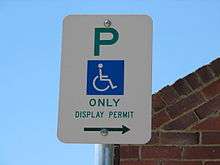Disabled parking permit
A disabled parking permit, also known as a disabled badge, disabled placard, handicapped permit, handicapped placard, handicapped tag, and "Blue Badge" in the European Union, is displayed upon parking a vehicle permitting the operator of a vehicle to special privileges regarding the parking of that vehicle. These privileges include parking in a space reserved for persons with disabilities, or in some situations, permission to park in a time-limited space for a longer time, or to park at a meter without payment.
European Union
In the European Union (EU), a disabled parking permit allows partial or total exemption from charges or penalties associated with the parking of a motor vehicle used by a badge-holder, and shows entitlement to use of dedicated parking bays and off-street parking (where they are provided). The concession extends in some places to partial or total exemption from tolls or general prohibitions on where a vehicle can be driven. Since 2000, all general disabled parking permits in the EU have been standardised to a common style and blue colour, leading to the officially-used designation "Blue Badge".[1][2] A Blue Badge issued in one country of the EU is generally given equal recognition in others with various exceptions as described for the countries below.
The privileges vary by area, but some include parking in no parking zones, extended time limit on time-limited parking areas, waived parking fees, and using pedestrian areas in urgent situations.[3]
United Kingdom

In the United Kingdom (UK), this scheme of permits was originally introduced (using Orange Badges) by the Chronically Sick and Disabled Persons Act 1970. Badges are issued as a right if a person meets certain statutory requirements, most of which are associated with actually being in receipt of certain disability benefits from the national Social Security system; additionally, a local authority can make concessionary issues of badges to persons who have a permanent disability which does not fall directly within the more rigid statutory requirements but which seriously impairs their mobility.
- General exceptions
The Great Britain (GB) Blue Badge scheme does not apply to parking away from public roads and local authority car parks, with the general concessions often not recognised at ports, airports and railway stations unless the operators have provided voluntary parking privileges.
- Parking Maps
Until 2010 Directgov provided a service that covers country wide customised maps for Blue Badge Holders with different base colours reflecting councils policies on Blue Badge Holder's parking.[4] In addition to council policies this service also pin pointed the location of different features specific to disabled community. There are a few dedicated Blue Badge sat-navs available, mainly from the specialist sat-nav company Navevo. See BBNav publicity for a likely list of integral features.
Since the cessation of the directgov service maps have been provided by online services such as the crowd-sourced BlueBadgeParking.com which also provides free Sat-nav downloads.
- Abuse
Abuse of Blue Badges in the UK can incur fines of up to £1,000. As of 2016, the Department for Transport found that 61 out of 152 authorities did not have a policy about prosecuting drivers fraudulently using Blue Badges. The number of prosecuted cases from 2015 is just under 1000.[5]
England and Wales
In England and Wales, Blue Badge holders are required (unless signs show otherwise) to display a Disabled Person's Parking Disc ("Clock") showing the time the vehicle was first parked so that a time limit can be enforced. Badge holders from elsewhere in the European Union will need to obtain a Clock (obtainable from their Issuing Office in the UK) to validate their badge otherwise the vehicle will be treated as if no badge were displayed.
- Local differences in parking rules
In London, the volume of traffic has led to restrictions upon the national scheme in some areas with local colour schemes used to restrict standard concessions to local residents, for example the permits are green in Camden, white in Westminster, purple in Kensington and Chelsea, and red in the City of London. In these cities and boroughs special rules and parking spaces are provided for Blue Badge holders.
Similar local schemes operate in other large towns or cities in the UK, for example Norwich operates a 'green badge scheme'.
Northern Ireland
The standard scheme only generally applies to on-street parking and is outlined on the Roads Service Northern Ireland website.[6] A "White Badge" is required for access to Pedestrian Zones.
Scotland
In Scotland, a local authority Parking Attendant (in addition to police and traffic wardens) has the power to inspect a Blue Badge; failure to allow this inspection is an offence. There are also proposals to extend the issue of badges to small children and a wider range of (temporarily or permanently) disabled people.
United States
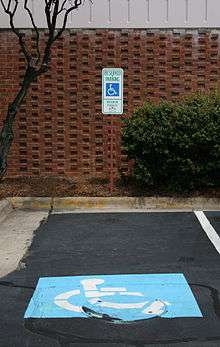
In the United States, reserved spaces are mandated by the Americans with Disabilities Act Accessibility Guidelines.[7]
Disabled parking space requirements
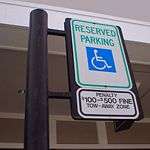
According to the Americans With Disabilities Act Handbook, "Accessible parking spaces should be at least 96 in (2440 mm) wide. Parking access aisles shall be part of an accessible route to the building or facility entrance..."[8]
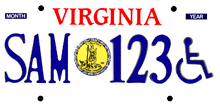
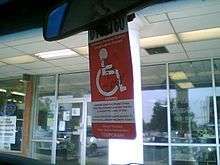
Disabled parking permits generally take the form of either specially marked license plates or a placard that hangs from the rear-view mirror. Plates are generally used for disabled drivers on their personal vehicle, while the portable disability placard can be moved from one vehicle to another with the disabled person, both when driving or when riding with another driver.
The medical requirements to obtain a permit vary by state, but are usually confined to specific types of disabilities or conditions. These as a general rule include the use of any assistive device such as a wheelchair, crutches, or cane, as well as a missing leg or foot. Some states also include certain cardiovascular, pain, or respiratory conditions. About half of US states (26) include blindness as a qualifying disability enabling the person to obtain a disability parking permit for use as a passenger, and 14 states include a disabled hand as a qualifying disability. Four states include deafness, and two states (Virginia and New York) include mental illness or developmental disabilities as qualifying disabilities.[9][10]
Disability parking placards come in various colors with the significance varying from state to state.
The availability of specially reserved parking spaces is regulated by both federal and state laws. Generally at least one space is available at any public parking location, with more being required based on the size of the parking lot and in some cases the type of location, such as a health care facility. Parking spaces reserved for disabled people are typically marked with the International Symbol of Access, though in practice, the design of the symbol varies widely.[11] Often, the parking space is delineated with blue lines instead of the white or yellow lines used elsewhere in the lot. Anyone parking in such reserved spaces must have their disability plate or mirror placard displayed, or else the car can be ticketed for illegal parking. In some major US cities, local law also allows such vehicles to park for free at city parking meters and also exempts from time limits on time parked. In the US states of California, Maryland, Massachusetts, South Carolina, Texas, Utah, and Virginia, holders of a Disabled parking permit are exempt from parking meter fees. In some states (including Virginia) accessible-designated parking meters exist, which, unless the permit holder is exempt, must be paid at the same rate as non-designated meters. One will also be subject to receiving a violation ticket if a valid disability license plate or placard is not displayed on the vehicle. Fraudulent use of another person's placard is heavily fined.
If traveling from other countries, requirements to obtain a parking permit vary from state to state. Some states will honour other country permits, while others require application as a visitor/tourist.[12]
Canada's provinces will honor a US state issued disabled plate or placard since US states will honor Canadian disabled plates and placards.
New York
The city does recognize valid placards from other jurisdictions for marked disabled parking spaces, all of which are in off-street lots.[13]
Disabled drivers from outside New York City who possess state-issued disability parking permits have claimed illegal discrimination and civil rights violations on the part of New York City. In 1991 a disabled elderly man from New Jersey was issued a ticket while parking in Brooklyn while displaying his New Jersey-issued disability parking placard.[14] In 1997 a woman with multiple sclerosis using a wheelchair was similarly issued a ticket while parking in New York City for displaying a non-NYC issued disability parking placard.[15] Both drivers maintain that failure to recognize non-NYC disability parking placards is a violation of their civil rights.
Integration with electric vehicle charging
In California alone, there are over 27,000 Plug in Electric Vehicles (PEV) with about 2,000 being added every month. While most PEV charging is done at home, the public charging infrastructure is also expanding, with 6218 public charging stations as of July 2013.[16] Although the number of PEVs is still a small portion of the cars on the road, and the number of PEVs with Handicap placards is much smaller still, the needs of handicap PEV drivers must be integrated with public charging spaces. Guidelines are that 1 in 25 PEV Charging Stations be made ADA space compliant.[17] Although not intuitively obvious, it's important to recognize that a PEV charging station is not parking space, rather a charging service, in the same manner that gas station fill up spots are not parking spaces. Electric vehicle charging stations that meet the ADA space requirements are not to be reserved exclusively for the use of persons with disabilities,[18] they are shared by any PEV needing to charge. Further more any PEV charging space, ADA space compliant or not, cannot be used by non-PEV vehicles, including those with handicap placards. Recommended signage, along with common courtesy, ask that ADA space compliant charging stations are to be used last.
Abuse
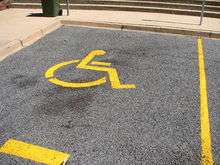
The abuse and misuse of disabled parking permits has been identified as a major problem in the US, with some estimates indicating the majority seen on the street are used or obtained fraudulently.[19] The substantial privilege and convenience granted by a permit provides a major incentive to use one illegally or obtain one fraudulently, and medical privacy law often confounds attempts to identify truly disabled individuals from abuses. In 1999, 19 of UCLA's current and former football players were charged with abuse of disabled parking placards.[20][21][22]
Abuse occurs under the following circumstances:
- A non-disabled driver using the vehicle, plate or placard of another person who is disabled without transporting that person. This often occurs with family members of disabled people.[23]
- Using an illegally purchased placard that originally was issued to another person.[23]
- Forging a physician's signature on the form submitted to the motor vehicle department.[24]
- Feigning or exaggerating symptoms of a medical condition in order to convince a physician to submit the form.
A related issue is physician approval of permits for medical conditions that don't actually qualify under that jurisdiction's requirements. Often this is simply an error on the physician's part due to not fully understanding the law. A common example is cognitive, psychiatric, or developmental conditions (such as autism), which in all but two states do not qualify for a permit. Such permits are still legal and valid, and most recipients honestly believe they have a qualifying disability. The result is far more permits than existing parking spaces can usually support, which often leaves more severely disabled individuals without a place to park.[25]
Disabled persons who hold parking permits but have invisible disabilities may be difficult to tell apart from fraudulent permit users.[26][27] On occasion, suspicion of fraud has led to hostility against legitimate permit holders.[28][29][30]
Oceania
Australia
In Australia, disabled parking permits are provided under the Australian Disability Parking Scheme,[31] which was established in September 2010 to harmonise disability permits across Australia.[32] Disabled parking permits are applied for through state and territory organisations, and rules for eligibility differ among jurisdictions.[31] If someone else parks in a disabled zone, he will be fined by either police or the council.
See also
References
| Wikimedia Commons has media related to Disabled parking. |
- ↑ "Neuer Parkausweis für Behinderte (English: New parking card for disabled". FAHRLEHRERVERBAND Baden-Württemberg e.V. Retrieved 29 April 2010.
- ↑ "Parking card for people with disabilities in the European Union: conditions in the member states" (PDF). European Commission. Archived from the original (pdf) on 28 November 2009. Retrieved 29 April 2010.
- ↑ "Parking card for people with disabilities in the European Union: conditions in the Member States" (PDF). ec.europa.eu. Retrieved 14 February 2017.
- ↑ "Directgov Blue Badge map". Directgov. Archived from the original on 18 April 2010. Retrieved 19 December 2009.
- ↑ Sawer, Patrick (31 December 2016). "Able-bodied motorists 'getting away' with disabled parking fraud". The Telegraph. Retrieved 13 February 2017.
- ↑ "Disabled Persons Badge Scheme for Northern Ireland". Roads Service Northern Ireland. Archived from the original on 3 January 2010. Retrieved 19 December 2009.
- ↑ "4.6 Parking and Passenger Loading Zones". ADA Accessibility Guidelines for Buildings and Facilities (ADAAG). United States Access Board. Retrieved 14 December 2016.
- ↑ U.S. Department of Justice (October 1991). Americans with Disabilities Act Handbook. Equal Opportunity Commission and the U.S. Department of Justice. p. 25.
|access-date=requires|url=(help) - ↑ "Disabled Parking Placards or License Plates Application" (PDF). Virginia Department of Motor Vehicles. Retrieved 19 December 2009.
- ↑ "Application for a Parking Permit or License Plates, for Persons with Severe Disabilities" (PDF). New York State Department of Motor Vehicles. Retrieved 19 December 2009.
- ↑ "www.youcantparkhere.com (A gallery of accessible parking symbols)". Retrieved 19 December 2009.
- ↑ "How do I obtain a disabled parking permit in the USA?". U.S. Department of State. Archived from the original on 10 December 2009. Retrieved 19 December 2009.
- ↑ "NYC DOT". nyc.gov.
- ↑ Hanley, Robert (5 June 1991). "New York Urged to Broaden Handicapped-Parking Rights". The New York Times.
- ↑ Page, Jeffrey (5 December 1997). "ENCOUNTERING THE WOODEN HEART OF LITTLE OLD N.Y.". The Record.
- ↑ Electric Vehicle Charging Station Locations
- ↑ "Interim Disabled Access Guidelines for 97-03 Electrical Vehicle Charging Stations" (PDF).
- ↑ "State of California Governor's Office of Planning and Research, Plug-In Electric Vehicles: Universal Charging Access Guidelines and Best Practices" (PDF).
- ↑ Shoup, Donald. "Ending the Abuse of Disabled Parking Placards" (PDF). Archived from the original (PDF) on 24 July 2014. Retrieved 4 October 2012.
- ↑ Peters, Justin. "Handicapped-Parking Fraud Is Just About the Jerkiest Crime Imaginable". Slate. Retrieved 13 February 2017.
- ↑ Berthelsen, Christian (29 July 1999). "College Football; 9 Enter Pleas in U.C.L.A. Parking Case". The New York Times. Retrieved 13 February 2017.
- ↑ Wharton, David (14 September 1999). "Five More Charged in Parking Scandal". Los Angeles Times. Retrieved 13 February 2017.
- 1 2 Chirbas, Kurt (29 July 2015). "California DMV cracks down on misuse of disability parking placards". latimes.com. Retrieved 2017-02-27.
- ↑ TEGNA. "One out of every 8 California drivers now has a disabled parking placard". KPNX. Retrieved 2017-02-27.
They also charged some drivers with fraud after they discovered forged doctor signatures on applications.
- ↑ Chirbas, Kurt (29 July 2015). "California DMV cracks down on misuse of disability parking placards". latimes.com. Retrieved 2017-02-27.
It brings to mind there are doctors out there who might be over-prescribing," said R. Michael Paravagna, a member of the Commission on Disability Access. "Maybe they are handing them out like candy.
- ↑ Bernstein, Sharon (6 May 2003). "Handicap That Allows Parking Isn't Always Obvious". Los Angeles Times. Retrieved 13 February 2017.
- ↑ Ayres, Ian. "How Can We Stop Handicap Fraud?". Freakonomics. Retrieved 13 February 2017.
- ↑ Invisible Disabilities Association (2004). "Looks Can be Deceiving". Retrieved 30 January 2013.
- ↑ Cline, Katie. "People with invisible disabilities face discrimination while using parking passes". The Red & Black. Retrieved 13 February 2017.
- ↑ Fleshler, David. "Parking lot vigilantes abuse woman with 'invisible' disability". Sun Sentinel. Retrieved 13 February 2017.
- 1 2 "Australian Disability Parking Scheme". Government of Australia. Retrieved 18 September 2018.
- ↑ "Mobility Parking Scheme". Roads and Maritime Services. Retrieved 10 November 2012.
External links
- BlueBadgeParking.com—a worldwide, crowd-sourced map of disabled parking locations with SatNav downloads]
- Federation Internationale de l'Automobile—information about disabled parking schemes around the world
